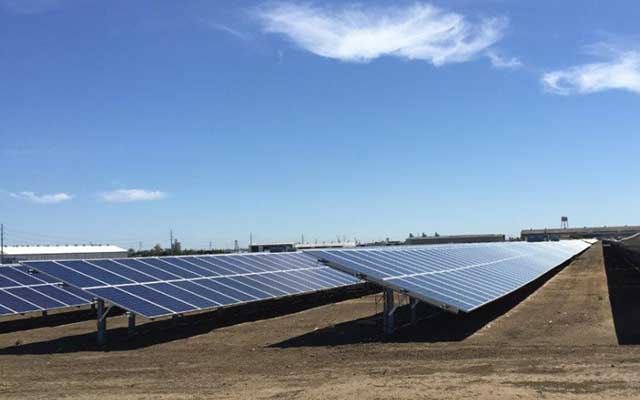2016 has been another record-breaking year for solar photovoltaic (PV) industry. More than 60 GWp of new solar PV installations have been added during the year. In year 2015, the annual market was about 50 GWp. Depending on the final quarter development in China, 2016 installations could even be close to 70 GWp. This would mean that the global cumulative installed PV capacity would be close to 300 GWp by the end of the year.
With the current PV capacity, about 2 percent of the global electricity demand will be covered by solar generation in 2017. China has the biggest annual market with more than 20 GWp, USA and Japan added about 10 GWp in 2016 and India around 5 GWp. It is expected that India will grow as the world’s second largest PV market in a couple of years.
Mid-term forecasts for global cumulative PV capacity by 2020 range from 600 GWp to 700 GWp, depending on the policy scenario assumed. In the long-term, the base scenario by European PV Technology and Innovation Platform (ETIP PV) assumes that the global cumulative PV capacity will be about 9000 GWp by 2050. This capacity would generate about one third of the annual electricity consumption in the world, assuming the demand growth scenario by IEA.
The main reason behind this rapid development is the dramatic price decrease of the solar PV modules. In real terms, the current PV module price, 0.40-0.50 USD/Wp, is only 10 percent of the price in 2008. According to IHS Markit, the module price will decrease below 0.30 USD/Wp by 2020. Long-term base scenario by ETIP PV would indicate the module price going downto 0.10 USD/Wp by 2050.
In addition to the modules, an installed PV system includes so called Balance of System (BoS) components like inverters, cables, mounting structures, installation and design work etc. The share of the BoS cost in a total PV system capital expenditure (CAPEX) depends on the size of the system, but it is currently less than half in large ground-mounted installations in the most competitive markets like India.
PV manufacturing is basically a semiconductor industry where increase in volumes automatically brings cost reduction. Historically, the price of PV modules has decreased by 20-25 percent every time the global cumulative installed capacity has doubled. Main reasons aremore efficient use of materials, better manufacturing processes and higher efficiency of the solar cells.
Currently, the average efficiency of PV modules is about 16 percent and is expected to increase to 30 percent by 2050. Best commercial modules already reach 23 percent efficiency. Increasing the efficiency automatically decreases the PV CAPEX because about half of the BoScost is area-related. Better efficiency means always a smaller area required for the PV modules.
Crystalline silicon-based (c-Si) modules have today more than 90 percent market share and they will remain the dominating PV technology in the foreseeable future. Multi-junction technologies, adding layers of different materials on top of silicon, will be increasingly used to raise the efficiency. The main benefit of silicon-based PV modules is that the main raw material, silicon, is the second most common element (after oxygen) in the crust of the earth. Most PV cells are made of silicon which is processed and purified from silicon dioxide, which is basically sand.
There are some thin film modules in the market, mainly made of cadmium telluride (CdTe) and copper indium gallium selenide (CIGS). But thin film technologies have lost their competitive edge against c-Si modules because silicon is ample and very cheap now. Thin films contain rare elements like indium and tellurium, which could be a problem if their manufacturing volumes were to increase ten or hundred fold as required by the future growth. Tellurium is about as rare as platinum or gold whereas silicon is about 60 million times more abundant than tellurium.
Currently, First Solar is the only thin film manufacturer among the ten largest PV module makers in the world. There are also other PV technologies like organic or dye-sensitised cells but they are still in the research or demonstration phase. They have a challenge with low efficiency and fast degradation in outdoor conditions, and it is not likely that they will ever be able to compete in large scale with c-Si modules.
With the continuing cost reduction, PV is already becoming competitive in many markets. For example in India, the Central Electricity Regulatory Commission (CERC) estimated in early 2016 that the average CAPEX for utility-scale PV was to be about 0.80 USD/Wp this fiscal year. Reduction in PV module prices during the year means that the CAPEX prices are now even lower than that, and the levelised cost of electricity (LCOE) with 5 percent real weighted average cost of capital (WACC) is about 40 USD/MWh without taxes in India.
In Mexico and some Middle Eastern countries, which have even better solar irradiation than India, we are already seeing PV power purchase agreement (PPA)price levels of 30 USD/MWh or lower. However, most of these projects are to be commissioned in a couple of years which means that they can take advantage of a further reduction in the PV module prices. Anyway, it looks likely that solar PV will be one of the cheapest forms of electricity generation in almost everywhere in the world sooner or later.
Eero Vartiainen, Solar Technology Manager, Fortum
editor@greentechlead.com

